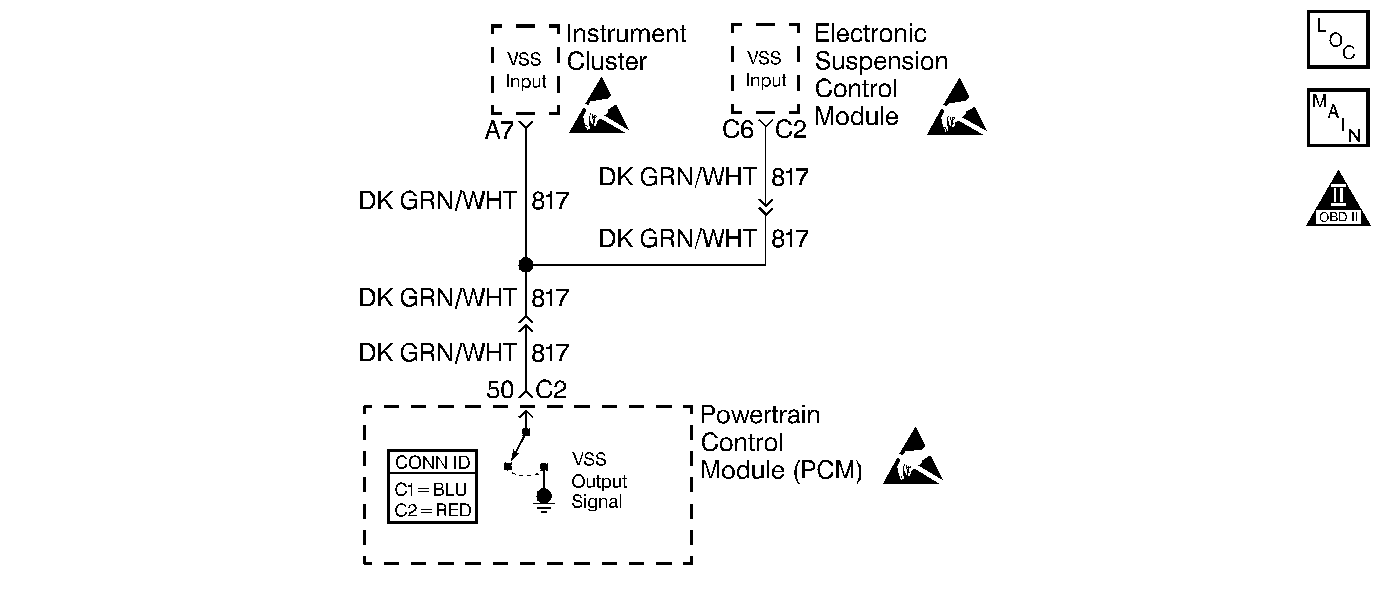
Circuit Description
A voltage is supplied to the Vehicle Speed Output circuit. The PCM creates the Vehicle Speed Output signal by pulsing the circuit to ground at a predetermined hertz rate. The PCM pulses the circuit at the same rate as the VSS input signal. The PCM monitors the voltage on the Vehicle Speed output circuit. If the PCM determines the voltage is out of the normal operating range, a DTC sets.
Conditions for Running the DTC
| • | The engine speed is greater than 400 RPM. |
| • | The ignition voltage is greater than 6 volts but less than 18 volts. |
Conditions for Setting the DTC
| • | The PCM detects that the commanded state of the driver and the actual state of the control circuit do not match. |
| • | All of the above conditions exist for a minimum of 5.0 seconds. |
Action Taken When the DTC Sets
| • | The powertrain control module (PCM) stores the DTC information into memory when the diagnostic runs and fails. |
| • | The malfunction indicator lamp (MIL) will not illuminate. |
| • | The PCM records the operating conditions at the time the diagnostic fails. The PCM stores this information in the Failure Records. |
Conditions for Clearing the MIL/DTC
| • | A last test failed (current DTC) clears when the diagnostic runs and does not fail. |
| • | A History DTC clears after forty consecutive warm-up cycles, if this or any other emission related diagnostic does not report any failures. |
| • | Use a scan tool in order to clear the MIL/DTC. |
Diagnostic Aids
Important:
• Remove any debris from the PCM\TAC module connector surfaces before
servicing the PCM\TAC module. Inspect the PCM\TAC module connector gaskets
when diagnosing/replacing the modules. Ensure that the gaskets are installed
correctly. The gaskets prevent contaminate intrusion into the PCM\TAC
modules. • For any test that requires probing the PCM or a component
harness connector, use the Connector Test Adapter Kit J 35616
. Using this kit prevents damage
to the harness/component terminals. Refer to
Using Connector Test Adapters
in Wiring Systems.
| • | Using Freeze Frame and/or Failure Records data may aid in locating an intermittent condition. If you cannot duplicate the DTC, the information included in the Freeze Frame and/or Failure Records data can aid in determining how many miles since the DTC set. The Fail Counter and Pass Counter can also aid determining how many ignition cycles the diagnostic reported a pass and/or a fail. Operate the vehicle within the same freeze frame conditions (RPM, load, vehicle speed, temperature etc.) that you observed. This will isolate when the DTC failed. |
| • | For an intermittent, refer to Symptoms . |
Test Description
The numbers below refer to the step numbers on the diagnostic table.
Step | Action | Value(s) | Yes | No | ||||
|---|---|---|---|---|---|---|---|---|
1 | Did you perform the Powertrain On-Board Diagnostic (OBD) System Check? | -- | ||||||
|
Important::
Does the vehicles speedometer indicate vehicle speed? | -- | Go to Diagnostic Aids | ||||||
3 |
Does the vehicle's speedometer indicate vehicle speed? | -- | Further diagnosis of circuit required. Go to Diagnostic System Check - Instrument Cluster in Instrument Panel, Gauges, and Console. | |||||
4 |
Did you find and correct the condition? | -- | ||||||
5 |
Important: Program the replacement PCM. Refer to Powertrain Control Module/Throttle Actuator Control Module Replacement . Replace the PCM. Is the action complete? | -- | -- | |||||
6 |
Does the scan tool indicate that this test failed? | -- | ||||||
7 | Select the Capture Info option and the Review Info option using the scan tool. Does the scan tool display any DTCs that you have not diagnosed? | -- | Go to the applicable DTC table | System OK |
